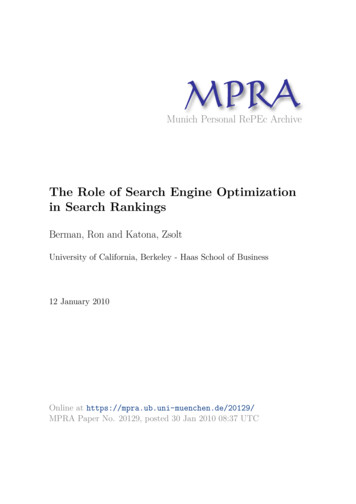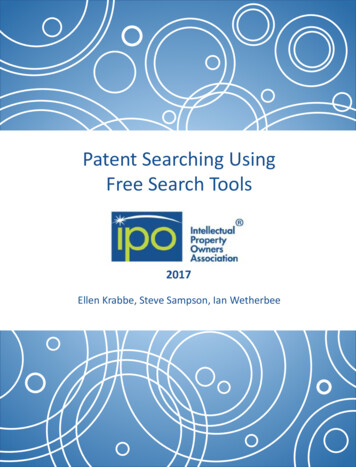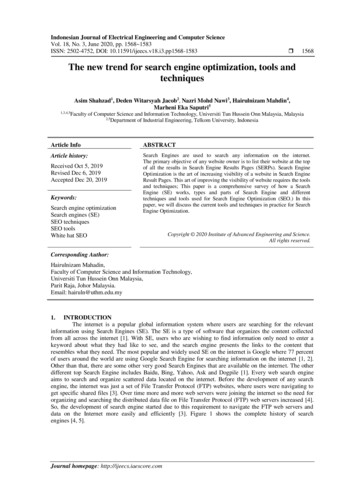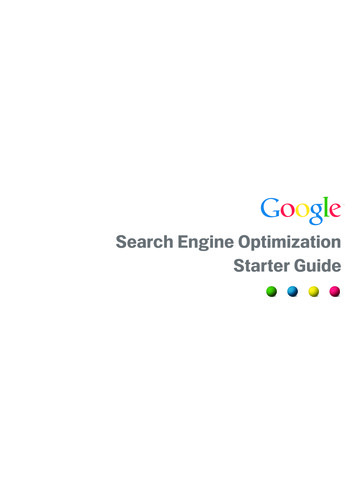
Transcription
Munich Personal RePEc ArchiveThe Role of Search Engine Optimizationin Search RankingsBerman, Ron and Katona, ZsoltUniversity of California, Berkeley - Haas School of Business12 January 2010Online at https://mpra.ub.uni-muenchen.de/20129/MPRA Paper No. 20129, posted 30 Jan 2010 08:37 UTC
The Role of Search Engine Optimization in SearchRankings Ron Berman and Zsolt Katona†January 12, 2010 Preliminaryversion. All comments welcome.Berman is a Ph.D. student and Zsolt Katona is an Assistant Professor at the HaasSchool of Business, UC Berkeley, 94720-1900 CA. E-mail: ron u.† Ron
The Role of Search Engine Optimization in SearchRankingsAbstractWeb sites invest significant resources in trying to influence their visibility in onlinesearch results. We study the economic incentives of Web sites to invest in this processknown as search engine optimization. We focus on methods that improve sites’ rankingamong the search results without affecting their quality. We find that the process isequivalent to an all-pay auction with noise and headstarts. Our results show that inequilibrium, under certain conditions, some positive level of search engine optimizationimproves the search engine’s ranking and thus the satisfaction of its visitors. In particular, if the quality of sites coincides with their valuation for visitors then search engineoptimization serves as a mechanism that improves the ranking by correcting measurement errors. While this benefits consumers and search engines, sites participating insearch engine optimization could be worse off unless their valuation for traffic is veryhigh. We also investigate how search engine optimization affects sites’ investment incontent and find that it can lead to underinvestment as a result of wasteful spendingon search engine optimization.
1IntroductionSearch engine marketing is becoming a dominant form of online advertising. By utilizing search marketing, Web sites that wish to advertise online can reach consumers atthe point when they search for a specific keyword. This makes such locations valuableto advertisers who can compete for appearing on the search results page. Most of thesearch engines allow web sites to submit bids for their so called sponsored links andgenerally the highest bidders win the most visible links, usually on the top of the list.In this “official” way of search advertising, sites get access to the right side1 of thesearch results page.Many advertisers, however, try to find their way to the top of the organic results listinstead of (or in addition to) competing for sponsored links. The collection of differentactions that a site can take to improve its position on the organic list is called searchengine optimization (SEO). This can be either done by making the site more relevantfor consumers, or by investing in different techniques that affect the search engine’squality ranking process. These two types of SEO techniques are sometimes referred toas white hat SEO and black hat SEO respectively. The important difference is that thelatter type only improves the ranking of a site among search results without affectingits quality, whereas the former type changes the site’s ranking by improving its contentand by increasing visitors satisfaction. In the rest of the paper we use SEO to referto the latter type of activities. These activities include techniques of creating externallinks to the site or changing the html source of the site’s pages to influence the outcomeof the automatic process that the search engine uses to evaluate each site’s relevance.Our goal is to investigate the economics of the SEO process and its effects onconsumers, advertisers and search engines. We introduce a model of the SEO processas an all-pay auction of link slots by a search engine to websites. The search engine’sgoal is to improve consumer welfare by displaying the most relevant links to visitors,who judge a site’s quality by the relevance of its content. The mechanism used is anasymmetric all-pay auction in which sites can invest to improve their rankings withoutimproving their quality. Our model diverges from traditional rent seeking analysisin two components. First, the existence of noise in the scoring mechanism of theauctioneer results in suboptimal slot allocations when SEO is not allowed. Second,1In some cases the search engine displays sponsored links on top of the organic results as well.1
asymmetries among the different sites yield scoring headstarts for each site during theauction. These assymetries stem from the difference in intrinsic qualities among sites,as well as from the different valuation each site places on visits by consumers.We find that under certain conditions black hat SEO can be advantageous to thesearch engine and increases consumer welfare in equilibrium. In particular, if sites’valuation for traffic is aligned with their relevance for consumers then the search engineis better off when allowing some positive level of SEO than when discouraging SEO.If, on the other hand, there are sites with high valuation for visits, but low relevancefor visiting consumers, then SEO is generally detrimental to the search engine andconsumer welfare. An example of such a “bad” site, which we call a spam site, is asite that advertises products for a very low price to lure visitors, but later on uses thevisitors’ credit card details for fraudulent activities2 .Search engines typically take a strong stance against black hat SEO and consider itcheating (see Google’s remarks about SEO). In some cases they entirely remove sitesthat are caught conducting such activities from the organic list3 . Search engines canalso invest significant amounts in reducing the effectiveness of certain SEO activities4 .To justify their position, search engines typically claim that allowing for SEO lowersthe quality of ranked websites. To analyze this claim, we further investigate how SEOaffects investment in content. We find that high effectiveness of SEO might result inunderinvestment in content when creating content is relatively expensive.Despite the apparent importance of the topic there has been very little researchdone on search engine optimization. At the same time, search engine optimizationhas grown to become a multi-billion dollar business5 . Many papers have focused onthe sponsored side of the search page and some on the interaction between the twolists. In all of these cases, however, the ranking of a website in the organic list isgiven as exogenous, and the possibility of investing in SEO is ignored. One puzzlingmessage that search engines convey is that the auction mechanism for sponsored links2Researchers estimate Benczur et al. (2008) that 10-20% of Web sites constitute spam.BBC News reported that Google has blacklisted BMW.de for breaching its guidelines. tm4In response to Google’s regular updates of its search algorithm, different sites shuffle up and downwildly in its search rankings. This phenomenon, which happens two or three times a year is calledthe “Google Dance” by search professionals who give names to these events as they do for hurricanes(see “Dancing with Google’s spiders”, The Economist, March 9, 2006).5See the survey conducted by seomoz.com at s.32
ensures that the best advertisers will obtain the links of highest quality, resulting inhigher social and consumer welfare. The comparison is done, however, with respectto random search lists, while it is obvious that organic search results are not random.Is not the case of SEO similar? If the most resourceful sites are the ones providingthe best links, why not let them invest in improving their rankings? To explore thisquestion we introduce the notion of an ordered search list. By comparing consumerwelfare resulting from searching on different lists, the efficiency of a ranking mechanismcan be measured, and different forms of displaying search results can be compared.The rest of the paper is organized as follows. Section 3 describes a simplified modelof the search process when a search engine displays a single result in response to asearch query. We examine how the SEO game affects content investment in Section 5.Finally, Section 6 generalizes our model in several ways to show that our main resultsare robust, and introduces the notion of an ordered results list for comparison amongsearch ranking mechanisms.2Relevant LiteratureThe advent of online advertising technologies and the rapid growth of the industry ledto an increase in the volume of research dedicated to this phenomenon. Works suchas those by Rutz and Bucklin (2007) and Ghose and Yang (2009) focus on consumerresponse to search advertising and the different characteristics that impact advertisingefficiency. Another major stream of research, including works by Edelman et al. (2007)and Varian (2007) focus mostly on the auction mechanism used by the different searchengines to allocate their advertising slots. More recent examples, such as those by Chenand He (2006), Athey and Ellison (2009) and Aggarwal et al. (2008) analyze modelsthat include both consumers and advertisers as active players. A number of recentpapers study the interplay between the organic list and the sponsored link. Katonaand Sarvary (2010) show that the top organic sites may not have an incentive to bidfor sponsored links. Xu et al. (2009) and White (2009) study how the search engine’sadvertising revenue from the sponsored links is affected trough the organic listings.Little attention was given to search engine optimization, although the use of SEOtechniques is common practice among companies dealing with search marketing. Thework of Xing and Lin (2006) resembles ours the most by defining “algorithm quality”3
and “algorithm robustness” to describe the search engine’s ability to identify relevantwebsites and eliminate non-relevant ones. Their paper shows that when advertisers’valuation for organic links is high enough, providers of SEO services are profitable,while search engines’ profits suffer. Considering our result that using SEO can improveconsumer welfare under noisy conditions, these results complement ours in explaining why search engines invest efforts in fighting SEO. An earlier work by Sen (2005)develops a theoretical model that examines the optimal strategy of mixing betweeninvesting in SEO and buying ad placements. The model surprisingly shows that SEOshould not exist as part of an equilibrium strategy.A primary feature of our model is the use of an all-pay auction to describe thegame websites are playing when competing for a location on a search engine’s organicresults list. A rent seeking process such as this is similar to the process of lobbying andother processes described and analyzed in Hillman and Riley (1987) and other works.An extension of the all-pay model to multiple players and multiple items is analyzedin Barut and Kovenock (1998), Baye et al. (1996) and Clark and Riis (1998). For asurvey of the literature on contests under different information conditions and contestsuccess functions, see Konrad (2007).Our use of all-pay auctions takes into account initial asymmetries among sites resulting from measurement error and different website qualities. The different qualities,measured as a relevance measure for consumers translate into a headstart in the initialscore calculated by the search engine to determine the auction winners. The existenceof such a headstart, which in many cases is analogous to differences in abilities of theplayers, results in different equilibria as described in Kirkegaard (2009) and analyzedunder more general conditions in Siegel (2009). Our application is unique in that itconsiders the cases where the initial headstart is biased by noise inherent in the qualitymeasurement process. Krishna (2007) is one of the few examples taking noise intoconsideration in an auction setting. This noise is the main reason for the initiallyinefficient allocation of organic link slots, which can be corrected by allowing for SEO.3ModelA search engine (SE) is a website that provides the following service to its visitors:they enter queries (search phrases) into a search form and the SE returns a number of4
results for this query displaying them in an ordered list. This list contains a number oflinks to other websites in the order of the relevance of their content for the given searchphrase. In our model, we focus on a single keyword and we assume that the relevance,or quality, of a search result is essentially the probability that a consumer is satisfiedwith the site once clicking on the link6 . We further assume that, for the purpose ofordering the search results, the SE’s objective is to maximize the expected consumersatisfaction7 hence its goal is to present the most relevant results to its visitors, andits utility is equal to the expected satisfaction level of consumers.In order to rank websites, the search engine uses information gathered from crawlingalgorithms and data mining methods on the Internet. Let qi denote the relevance ofsite i in the context of a given keyword. It is reasonable to assume that the searchengine can only measure quality with an error, and cannot observe it directly. Theinitial quality score that the SE assigns to a site i is thus sSi qi σεi , where εi areassumed to be independent and are drawn from the same distribution. If the Web sitesdo not take any action the results will be ordered according to the sSi ’s as assigned bythe search engine. If, however, Web sites can invest in SEO, they have the option toinfluence their position after observing the initial scores. The effectiveness of SEO ismeasured by the parameter α in the following way. If site i invests bi in SEO, its finalscore becomes sFi sSi αbi . That is, depending on the effectiveness of SEO, sitescan influence their scores which determines their final location in the organic list ofsearch results. We assume that there are n websites providing information or productsto consumers and that those sites derive some utility from the visiting consumers. Thesites’ profits primarily depend on their traffic. We assume that site i derives utilityvi (t) of having t customers click its link in a given time period.The behavior of the unit mass of consumers in our model is relatively simple. Ifconsumers are presented with one link, they click on it, and are satisfied with probability qi , receiving a utility normalized to 1 if satisfied. If there are k 1 links, theconsumers traverse the list of links in a sequential order. When a consumer is satisfiedwith the site visited, the searching ends. When a consumer is dissatisfied with a site6Modeling consumer satisfaction as a 0-1 variable is relatively simple, but captures the essence. InSection 5 we will discuss alternative formulations where qi is the average utility that a consumer gainsafter clicking on link i.7Since providing these results is typically the search engines core service to consumers its reputationand long term profits strongly depend on the quality of this service.5
visited, he continues to the next link with probability ci . We provide full details of thesearch sequence by consumers in Section 6.2 dealing with multiple search results.The sequence of the game is as following. First the search engine measures therelevance of each website and publishes sSi qi σεi . Next, the websites, after observingsSi , simultaneously decide how much they want to invest in SEO, changing the scoresto sFi sSi α · bi . The search engine then recalculates the scores and displays anordered list of search results sorted in a decreasing order of the final site scores sFi .Finally, visitors click on the results according to their order until being satisfied, andpayoffs are realized at the end. Our assumption on the timing of the above events issomewhat simplistic, but it is the most plausible way of capturing Web sites’ reactionsto their ranking results and their subsequent investment in SEO.We start our analysis by examining a simple case that illustrates the main forcesgoverning SEO. In this case, we assume that there is one organic link displayed on theSE (k 1) and that there are two bidders (n 2) with q1 q2 . We then generalize tothe case of n 2 sites, and multiple k 1 links. To illustrate the effect of SEO we alsocompare the equilibrium case to one in which sites can choose to invest in improvingtheir content, thus increasing their quality qi .4SEO Equilibrium - One linkWe assume that there is one organic link, and that the utility sites derive from incomingtraffic is linear in traffic, such that vi (t) vi t and v1 v2 . Since there is a unit mass ofconsumers that click on the link displayed in the search result, the valuation that siteshave for the appearing on the list is v1 and v2 , respectively. We set the distribution of εito take the value of either 1 or 1 with equal probabilities. We assume σ q1 q2 /2to ensure that the error can affect the ordering of sites 8 .First, as a benchmark, let us examine the case in which there is no search engineoptimization possible, i.e. when α 0. In this case sites cannot influence their positionamong the search results. The SE’s expected utility is then 43 q1 14 q2 . The effect ofthe error in the SE’s measurement process is clear. With a certain probability (1/4 inthis case), the order will be suboptimal leading to a drop in expected utility comparedto the first best case of q1 .8Otherwise the order remains the same and the setup is equivalent to one with no error6
When search engine optimization is effective, i.e., when α 0, websites have atool to influence the order of results. The ability to influence, however, is typicallyasymmetric, since sites have different starting scores sSi . A site that is in the firstposition in the SE’s initial ranking has a headstart and hence can remain the first evenif it invests less in SEO than its competitor. Another characteristic of the game sitesplay is that their SEO investment is sunk no matter what the outcome of the game is.That is, sites essentially participate in an all-pay auction with headstarts (Kirkegaard2009). These games are generalizations of basic all-pay auctions without a headstart.In these auctions players submit bids for an object that they have different valuationsfor. The player with the highest bid wins the object, but all players have to pay theirbid to the auctioneer (hence the “all-pay auction” term). If players have headstartsthen the winner is the player with the highest sum of bid plus headstart.The level of headstarts depends in our model on the starting scores and hence onthe error. For example, if q1 q2 and ε1 ε2 1, the error does not affect the order2. Asnor the difference between the starting scores and the headstart of site 1 is q1 qαthe size of the headstart decreases with α, the more effective SEO is, the less the initialdifference in scores matters. Even if site 1 is more relevant than site 2, it is not alwaysthe case that it has a headstart. If ε1 1 and ε2 1 then sS1 q1 σ sS2 q2 σgiven our assumption on the lower bound on σ. Thus, player 2 has a headstart ofq2 2σ q1.αBy analyzing the outcome of the all-pay auction given the starting scores, wecan determine the expected utility of the SE and the websites.All-pay auctions with complete information typically do not have pure-strategyNash-equilibria, but the unique mixed strategy equilibrium is very intuitive. In asimple auction with two players (with valuations v1 v2 ) both players mix between0 and v2 with different distributions9 . The player with the higher valuation (player1) wins with the higher probability: v1 /2v2 and the other player’s surplus is 0. Thus,only the player with the highest valuation makes a positive profit in expectation, butthe chance of winning gives an incentive to the other player to submit positive bids. Inthe case of an all-pay auction with headstarts the equilibrium is very similar and theplayer with the highest sum of valuation plus headstart wins with higher probabilityand the other player’s expected surplus is 0. The winner’s expected surplus is equal tothe sum of differences in valuations and headstarts.9See the Appendix for detailed bidding distributions.7
4.1The effect of SEO on efficiency and consumer welfareTo examine the outcomes of the SEO game, we use E(α) E(α; σ, v1 , v2 , q1 , q2 ) todenote the efficiency of the auction. In this case it is simply the probability that theplayer with the more relevant link wins the auction (that is, player 1). Note that theefficiency coincides with the search engine’s objective function as it wants the morerelevant link to come up first. The payoff of the search engine is a linear function ofthe efficiency:πSE q2 (q1 q2 )E(α)If there is no SEO, that is when α 0 (and σ q1 q2 /2), we have E(0) 3/4.Our goal is therefore to determine whether the efficiency exceeds this value for positiveα SEO effectiveness levels. It is useful, however, to begin with analyzing how theefficiency depends on valuations and qualities for given α and σ values. The followingLemma summarizes our initial results.Lemma 1 For any fixed α and σ, E(α; σ, v1 , v2 , q1 , q2 ) is increasing in v1 and q1 andis decreasing in v2 and q2 .Thus, the efficiency of the ranking increases when the most relevant site becomeseven more relevant and also when its valuation for clicks increases. When there is notSEO, that is α 0, the Lemma holds because the efficiency simply does not changewith v1 , v2 , q1 , q2 , but when α 0 the efficiency strictly increases and decreases in therespective variables. In essence the Lemma tells us that no matter how effective SEOis, the less sites valuations are aligned with their relevance levels, the less efficient therankings are.The following proposition summarizes the main result of our paper, showing howSEO affects the efficiency of the ranking.Proposition 11. For any σ q1 q2 /2, there exists a positive α̂ α̂(σ, v1 , v2 , q1 , q2 ) SEO effectiveness level such that E(α̂) E(0).2. If v1 /v2 3/2 then for any σ q1 q2 /2, there exists a positive α̂ α̂(σ, v1 , v2 , q1 , q2 )such that E(α̂) E(0).8
3. There always exist σ̃ and α̃ such that E(α̃; σ̃, v1 , v2 , q1 , q2 ) E(0; σ̃, v1 , v2 , q1 , q2 ).The first part of the proposition tells us that for any level of error there is a positivelevel of SEO that does not reduce the efficiency of the ranking. Practically, if the levelof SEO is not too high then firms will not invest enough to alter the rankings.The latter parts yield more interesting results. Essentially, they show that positivelevels of search engine optimization do improve the efficiency of the ranking in somecases. When high quality sites value visitors relatively high compared to lower qualitysites, SEO is beneficial to both the search engine and consumers regardless of the levelof error. If valuations are closer to each other or if valuations are misaligned withqualities, then this only holds for small levels of error.The intuition is as follows. The SEO mechanism favors bidders with high valuations.Since the SE cannot perfectly measure site qualities, this mechanism corrects some ofthe error when valuations increase monotonically in quality. When lower quality siteshave high valuation for traffic, however, SEO creates incentives that are not compatiblewith the utilities of consumers or the search engine. In this latter case, the highvaluation sites which are not relevant can get ahead by investing in SEO. Examplesare cases of “spammer” sites that mislead consumers. In these cases consumers do notgain any utility from visiting such sites, but the sites may profit from consumer visits.Arguably, such cases of misalignment are rare, since sites that make more money fromtheir visitors can afford to offer higher quality content.The fact the SE is better off allowing some positive level of SEO does not clarifywhat the optimal level of SEO is. In particular, how does it depend on the variance ofthe measurement error? To answer this, let Â(σ) denote the set of α SEO effectivenesslevels that maximize the search engine’s utility function. For two sets A1 R andA2 R, we say that A1 A2 if and only if for any α1 A1 there is an α2 A2 suchthat α2 α1 and for any α2′ A2 there is an α1′ A1 such that α1′ α2′ .Corollary 1 If v1 /v2 3/2, then the optimal SEO effectiveness is increasing as thevariance of the measurement error increases. In particular, for any σ1 σ2 0, wehave Â(σ1 ) Â(σ2 ).We have already shown that SEO can be beneficial because it can serve as a mechanism correcting the search engine’s error when measuring how relevant sites are. The9
above corollary tells us that if the error is higher more effective SEO is required tocorrect the error.4.2The effect of SEO on advertiser profitsWhen there is a positive level of SEO effectiveness, sites have a natural incentive toinvest in SEO, which they do not have when α 0. In the extreme case of α thedifference in initial scores dissipates and the game becomes a regular all-pay auction.If, for example, v1 v2 then player 1’s expected payoff is v1 v2 , whereas player 2makes nothing in expectation. Comparing this to the case in which there is no SEO- player 2 making v2 /4 and player 1 making 3v1 /4 - reveals that player 2 is worse offwith SEO whereas player 1 is better off iff v1 4v2 . This implies that high levels ofSEO only increase profits for sites with outstanding valuations. The following corollaryprovides detailed results on the sites’ payoffs.Corollary 21. If v1 v2 then Player 2’s payoff is decreasing in α.2. If v1 v2 there always exists an α 0 such that Player 1 is better off with an2SEO effectiveness level of α α than with α 0. If v1 4v2 or σ vv21 q1 q2then Player 1 is strictly better off.The player with the lower valuation is therefore worse off with higher SEO. Player1, on the other hand, is better off with a certain positive level of SEO, especiallyif its valuation is much higher than its competitor’s and if the measurement erroris small. The intuition from the former follows from the fact that higher levels ofSEO emphasize the differences in valuations, and the higher the difference the morelikely that the higher valuation wins. For the latter condition, smaller measurementerrors make it easier for the player with the higher starting score to win and to takeadvantage of SEO. The corollary shows that the player with the higher valuation isgenerally happy with some positive level of SEO, but further analysis (see the proof)suggests that it is not clear whether Player 1 or the search engine prefer a higher levelof SEO.10
5Investing in Quality of Content and SEOSo far we have focused on the investment that sites can make to improve their rankingwithout affecting their relevance. We now consider the possibility that before investing in SEO, sites can make an investment that improves their quality of content andtherefore the relevance of the link that the search engine is considering to display. Weextend the game and add a content investment stage before the SEO stage. In thisfirst round, sites can decide how much they want to spend on improving their qualityof content and given these quality levels they decide how much to invest in SEO as inSection 4. All other assumptions are the same: two sites are competing for one organiclink. Let c denote the marginal cost of increasing quality10 .Before exploring the details of this setup let us discuss how we define quality ofcontent. In our basic setup qi was simply the probability of a visitor clicking on a linkbeing satisfied with the content she finds. Here, we treat quality in a more general wayby assuming that qi is the expected utility a consumer derives by clicking on site i’slink. Note that if consumer satisfaction is a 0 1 variable then the expected utilityis equal to the probability of satisfaction. There are two ways how an investment incontent quality could affect sites in the SEO stage. First, it increases the chance ofthe link being displayed on the top of the organic list by the search engine, with orwithout SEO. Second, it can change sites valuation of visitors. In our basic setup vdenotes the valuation for the link, but given that the search engine has a unit massof visitors that all click on the first link, this is strictly proportional to the averageprofit per individual visitor that the sites makes (including both satisfied and nonsatisfied visitors). It is reasonable to assume that an investment in the quality ofcontent increases this quantity by improving customer satisfaction levels. Thereforethe investment can also increase the valuation of the site getting the top link. We firstignore this effect and focus on the case in which valuation is not affected by the qualityinvestment.10We assume that content costs are linearly increasing, however, a convex cost function would yieldsimilar results11
5.1Fixed ValuationsHere, we solve a game in which sites’ valuations for getting in the top position is fixedand not affected by the quality investment. As a benchmark, let us consider the casewhen there is no SEO, i.e. α 0. For simplicity we also assume that σ 0, that is,there is no measurement error. Then the game becomes a one-shot game, essentiallyan all-pay auction, where the winner gets all the benefits. As we mentioned before,these games do not have pure-strategy equilibria, but the mixed strategy equilibria arevery intuitive. The site with the higher valuation (e.g. player 1) wins the auction witha higher probability (1 v2 /2v1 ) and has an expected payoff of v1 v2 , whereas theother player had an expected payoff 0. To make the analysis simple, we exam
done on search engine optimization. At the same time, search engine optimization has grown to become a multi-billion dollar business5. Many papers have focused on the sponsored side of the search page and some on the interaction between the two lists. In all of these cases, however, the ranking of a website in the organic list is










